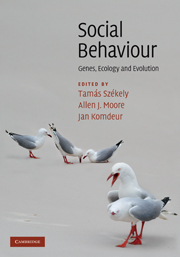Book contents
- Frontmatter
- Contents
- List of contributors
- Introduction: The uphill climb of sociobiology: towards a new synthesis
- Profile: Undiminished passion
- Part I Foundations
- Part II Themes
- 7 Aggression: towards an integration of gene, brain and behaviour
- Profile: From behavioural observations, to genes, to evolution
- 8 Social influences on communication signals: from honesty to exploitation
- Profile: Reputation can make the world go round – or why we are sometimes social
- 9 Important topics in group living
- Profile: A haphazard career
- 10 Sexual behaviour: conflict, cooperation and coevolution
- Profile: In celebration of questions, past, present and future
- 11 Pair bonds and parental behaviour
- Profile: Mating systems and genetic variation
- 12 Adaptations and constraints in the evolution of delayed dispersal: implications for cooperation
- Profile: Selections from a life in social selection
- 13 Social behaviour in microorganisms
- Profile: The de novo evolution of cooperation: an unlikely event
- 14 Social environments, social tactics and their fitness consequences in complex mammalian societies
- Profile: Evolutionary genetics and social behaviour: changed perspectives on sexual coevolution
- 15 Social behaviour in humans
- Profile: Genes and social behaviour: from gene to genome to 1000 genomes
- Part III Implications
- Species index
- Subject index
- References
14 - Social environments, social tactics and their fitness consequences in complex mammalian societies
Published online by Cambridge University Press: 05 June 2012
- Frontmatter
- Contents
- List of contributors
- Introduction: The uphill climb of sociobiology: towards a new synthesis
- Profile: Undiminished passion
- Part I Foundations
- Part II Themes
- 7 Aggression: towards an integration of gene, brain and behaviour
- Profile: From behavioural observations, to genes, to evolution
- 8 Social influences on communication signals: from honesty to exploitation
- Profile: Reputation can make the world go round – or why we are sometimes social
- 9 Important topics in group living
- Profile: A haphazard career
- 10 Sexual behaviour: conflict, cooperation and coevolution
- Profile: In celebration of questions, past, present and future
- 11 Pair bonds and parental behaviour
- Profile: Mating systems and genetic variation
- 12 Adaptations and constraints in the evolution of delayed dispersal: implications for cooperation
- Profile: Selections from a life in social selection
- 13 Social behaviour in microorganisms
- Profile: The de novo evolution of cooperation: an unlikely event
- 14 Social environments, social tactics and their fitness consequences in complex mammalian societies
- Profile: Evolutionary genetics and social behaviour: changed perspectives on sexual coevolution
- 15 Social behaviour in humans
- Profile: Genes and social behaviour: from gene to genome to 1000 genomes
- Part III Implications
- Species index
- Subject index
- References
Summary
Overview
In this chapter we outline proximate processes that favour group formation and lead to the emergence of social structure in mammalian societies, particularly complex societies. We operationally define a mammalian society as complex if its social structure includes social coalitions, social alliances or social queues – well known from primates, elephants and cetaceans but also present in, for instance, some carnivores, bats, rodents and ungulates. We consider how social structure can lead to a disparity in the benefits and costs acquired by group members, and how this leads to conflicts of interest between them. We detail the social and reproductive tactics that individuals use when conflicts arise, and consider the fitness consequences associated with these tactics. We illustrate most key points using observational studies of free-ranging mammals, because experimental studies are rare, and we draw examples from a broad range of social systems and mammalian orders.
Introduction
How do complex societies emerge from a life in groups? Living in groups inevitably results in conflicts of interest between group members. The specific forms of these conflicts are likely to affect the strategies to cope with them. Not only will the details of these strategies shape the social relationships we can observe, they may be the consequences of evolutionary processes, and are likely to have resulted in the social complexity described for many mammalian societies.
- Type
- Chapter
- Information
- Social BehaviourGenes, Ecology and Evolution, pp. 360 - 390Publisher: Cambridge University PressPrint publication year: 2010
References
- 5
- Cited by



